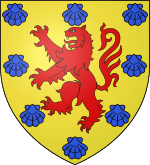Guy II of Dampierre
| Guy II of Dampierre | |
|---|---|
|
Coat of arms of Dampierre-Bourbon | |
| Spouse(s) | Mathilde of Bourbon |
| Noble family | House of Dampierre |
| Father | William I of Dampierre |
| Mother | Ermengarde of Mouchy |
| Died | 18 January 1216 |
Guy II of Dampierre (died 18 January 1216) was constable of Champagne, and Lord of Dampierre, Bourbon and Montluçon. He was the only son of William I of Dampierre, Lord of Dampierre, and Ermengarde of Mouchy. William I of Dampierre was the son of Guy I, Lord of Dampierre and Viscount of Troyes, and Helvide de Baudémont.
Guy II participated in the Third Crusade as a member of an advance party who initiated the Siege of Acre in the fall of 1189.[1][2] In 1191, in the Holy Land, he was considered a supporter of Conrad of Montferrat.[3]
In 1212, King Philip II of France tasked Guy with overthrowing Count Guy II of Auvergne. Guy successfully completed this task by taking Tournoël Castle in December 1213. His participation in the Battle of Bouvines in 1214, was decisive in the French victory.
Marriage and offspring
In 1186, he married Mathilde of Bourbon, a daughter of Archambaud of Bourbon and Alix of Burgundy.[4] She was a granddaughter of Archambault VII, Lord of Bourbon. Her father died before her grandfather, leaving him without a male heir. Consequently, she inherited Bourbon and thus the House of Dampierre acquired the Lordship of Bourbon.
Guy and Mathilde had seven children:[4]
- Archambaud VIII (1189-1242), Lord of Bourbon[4]
- William II (1196-1231), married Margaret II, Countess of Flanders and Hainaut (d. 1280),[4] a daughter of Latin Emperor Baldwin I of Constantinople
- Philippa Mahaut (d. 1223), married in 1205 to Guigues IV, Count of Forez (d. 1241)
- Guy III of Dampierre (d. 22 March 1275)
- Marie, married:
- around 1201 to Hervé of Vierzon
- in 1220 to Henry I of Sully
- Joan
- Margaret
References
- ↑ The Third Crusade:Richard the Lionhearted and Philip Augustus, The Later Crusades, 1189-1311, Vol. 2, ed. Kenneth M. Setton, Robert Lee Wolff and Harry W. Hazard, (University of Wisconsin Press, 1969), 51
- ↑ Itinerarium Regis Ricardi, vol. I, Chapter XXXI, ed. by William Stubbs: Chronicles and Memorials of the Reign of Richard I, in: Rolls Series, vol. 38, 1864, vol. 1, p. 74
- ↑ Gesta Regis Henrici Secundis et Gesta Regis Ricardi Benedicti abbatis, ed. by William Stubbs, in: Rolls Series, vol. 49, 1867, vol. 2, p. 187
- 1 2 3 4 Theodore Evergates, The Aristocracy in the County of Champagne, 1100-1300, (University of Pennsylvania Press, 2007), 217.
